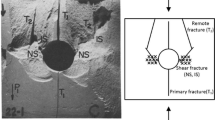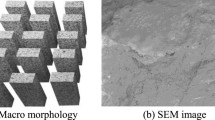Abstract
The aim of this paper is to estimate fracture angles in deep-seated rock bursts encountered in intact hard rock tunnels. The fracture angles of fault planes in rock burst failure are analytically formulated by employing stress analysis based on Mohr’s circle construction. Mohr’s circle construction suits well for representing the rock burst stress states including the static loading and dynamic unloading processes existing at or near the excavation surface. Four fracture angles can be precisely predicted using the proposed mathematical models, including two minimum angles for two conjugate planes where the shear stress is equal to the maximum static shear stress τ max while the normal stress approaches to zero, and two maximum angles for two conjugate planes where the normal stress is reduced from σ 1 to σ 1/2 while shear stress increases markedly from ±(σ 1–σ 3)/2 to the maximum dynamic shear τ dmax = ±σ 1/2. For validation of the analytical solutions to fracture angles, rock burst experiments on Laizhou granite were conducted using a modified true-triaxial apparatus. The predicted fracture angles are compared very well with the results obtained from the laboratory rock burst tests and are in good agreement with the in situ observations. The proposed solutions to the fracture angle are a function of the static stresses only which can be known a priori from a field survey.


















Similar content being viewed by others
References
Alexeev AD, Revva VN, Alyshev NA, Zhitlyonok DM (2004) True triaxial loading apparatus and its application to coal outburst prediction. Int J Coal Geo 58:245–250
Brady BHG, Brown ET (2005) Rock mechanics for underground mining. Kiuwer Academic Publishers, New York
Cai M (2013) Principles of rock support in burst-prone ground. Tunnel Underg Space Technol 36:46–56
Cai M, Kaiser PK, Tasaka Y, Minami M (2007) Determination of residual strength parameters of jointed rock masses using the GSI system. Int J Rock Mech Min Sci 44:247–265
Chen JT, Feng XT (2006) True triaxial experimental study on rock with high geostress. Chin J Rock Mech 25:1543–1573
Chen BR, Feng XT, Ming HJ, Zhou H, Zeng XH, Feng GL, Xiao YX (2012) Evolution law and mechanism of rock burst in deep tunnel: time delayed rock burst. Chin J Rock Mech Eng 31(3):561–569
Cheon DS, Jeon S, Park C, Ryu C (2006) An experimental study on the brittle failure under true triaxial conditions. Tunnel Underg Space Technol 21:448–499
Cho SH, Ogata Y, Kaneko K (2003) Strain rate dependency of the dynamic tensile strength of rock. Int J Rock Mech Sci 40:763–777
Cho SH, Qgata Y, Kaneko K (2005) A method for estimating the strength properties of a granitic rock subjected to dynamic loading. Int Rock Mech Min Sci 42:561–581
Cox SJD, Scholz CH (1988) On the formation and growth of faults: an experimental study. J Struct Geol 10:413–430
Durrheim RJ, Haile A, Roberts MKC, Schweizer JK, Spottiswoode SM, Klokow JW (1998) Violent failure a remnant in a deep South African gold mine. Tectonophysics 289(1–3):105–116
Feng XT, Chen BR, Ming HJ, Wu SY, Xiao YX, Feng GL, Zhou H, Qiu SL (2012) Evolution law and mechanism of rock bursts in deep tunnels: immediate rock burst. Chin J Rock Mech Eng 31(3):433–444
Gong QM, Yin LJ, Wu SY, Zhao J, Ting Y (2012) Rock burst and slabbing failure and its influence on TBM excavation at headrace tunnels in Jinping II hydropower station. Eng Geol 124:98–108
Gu MC, He FL, Chen CZ (2002) Study of rock burst in Qingling tunnel. Chin J Rock Mech Eng 21(9):1324–1329
He MC, Zhao F (2013) Laboratory study of unloading rate effects on rock burst. Disaster Adv 6(9):11–18
He MC, Miao JL, Li DJ, Wang CG (2007) Experimental study on rock burst processes of granite specimen at great depth. Chin J Rock Mech Eng 26(5):865–876
He MC, Miao JL, Feng JL (2010) Rock burst process of limestone and its acoustic emission characteristics under true-triaxial unloading conditions. Int J Rock Mech Min Sci 47:286–298
Horii H, Nemat-Nasser S (1985) Compression-induced microcrack growth in brittle solids: axial splitting and shear failure. J Geophys Res 90:3105–3125
Hou ZS, Gong QM, Sun ZH (2011) Primary failure types and their failure mechanisms of deep buried and intact marble at Jinping II hydropower station. Chin J Rock Mech Eng 30(4):727–732
Hua AZ, You MQ (2001) Technical note: rock failure due to energy release during unloading and application to underground rock burst control. Tunnel Underg Space Technol 16:241–246
Jaeger JC, Cook NGW, Zimmerman RW (2007) Fundamentals of rock mechanics, MA02148-5020USA. Blackwell, USA
Jeong HS, Kang SS, Obara YZ (2007) Influence of surrounding environments and strain rates on the strength of rocks subjected to uniaxial compression. Int J Rock Mech Min Sci 44:321–331
Karser PK, McCreath DR, Tannant DD (1996) Canadian rock burst support handbook. MIRARCO/Geomechanics Research Centre, Sudbury
King GCP, Sammis CG (1992) The mechanisms of finite brittle strain. Pure Appl Geophys 138:611–640
Michlmayr G, Cohen D, Or D (2012) Sources and characteristics of acoustic emissions from mechanically stressed geologic media—a review. Earth Sci Rev 112:97–114
Mogi K (1967) Effect of intermediate principal stress on rock failure. J Geophys Res 72:5117–5131
Mogi K (1971) Fracture and flow of rocks under high triaxial compression. J Geophys Res 76:1255–1269
Mogi K (2007) Experimental rock mechanics. Taylor & Francis Group, London
Ortlepp WD (2000) Observation of mining-induced faults in an intact rock mass at depth. Int J Rock Mech Min Sci 37:423–436
Ortlepp WD, Armstrong R, Ryder JA, O’Connor D (2005) Fundamental study of micro-fracturing on the slip surface of mine-induced dynamic brittle shear zones. In: Sixth international symposium rock burst and seismicity in mines, Australia, 2005, pp 229–37
Paterson MS (1958) Experimental deformation and faulting in Wombeyan marble. Bull Geol Soc Am 69:46–467
Reches Z (1999) Mechanisms of slip nucleation during earthquakes. Earth Planet Sci Lett 170:475–486
Reches Z, Lockner DA (1994) Nucleation and growth of faults in brittle rocks. J Geophys Res 99(B9):19159–19173
Savage JC, Byerlee JD, Lockner DA (1996) Is internal friction friction? Geophys Res Let 23(5):487–490
Tan YA (1989) The mechanism research of rock burst. Hydrogeol Eng Geol 1:34–38
Tan YA (1991) Rock burst characteristics and structural effects of the rock mass. Sci China (Series B) 9:985–991
Tarasov BG (2014) Hitherto unknown shear rupture mechanism as a source of instability in intact hard rocks at highly confined compression. Tectonophysics 621:69–84
Tarasov BG, Dyskin AV (2005) The phenomenon of anomalous rock embrittlement. In: Sixth international symposium rock burst and seismicity in mines, Australia, 2005, pp 311–317
Tarasov BG, Potvin Y (2013) Universal criteria for rock brittleness estimation under triaxial compression. Int J Rock Mech Min Sci 59:57–69
Tarasov BG, Randolph MF (2008) Frictionless shear at great depth and other paradoxes of hard rocks. Int J Rock Mech Min Sci 45:316–328
Tarasov BG, Randolph MF (2011) Superbrittleness of rocks and earthquake activity. Int J Rock Mech Min Sci 48:888–898
Wang JA, Park HD (2001) Comprehensive prediction of rock burst based on analysis of strain energy in rocks. Tunnel Underg Space Technol 16:49–57
Wawersik WR, Carlson LW, Holcomb DJ, Williams RJ (1997) New method for true triaxial testing. Int J Rock Mech Min Sci 34(3–4):330e1–330e14
Wei YJ, Anand L (2008) On micro-cracking, inelastic dilatancy, and the brittle–ductile transition in compact rocks: a micro-mechanical study. Solids Struct 45:2785–2798
Xu LS (2003) Research on the experimental rock mechanics of rock burst under unloading condition. J Chongqing Jiaotong Univ 22(1):1–4
Xu LS, Wang LS, Li YL (2002) Study on mechanism and judgment of rock bursts. Rock Soil Mech 23(3):300–303
Acknowledgments
Financial support from the Special Funds for the National Natural Science Foundation of China (Key Project) under Grant No. 51134005 is gratefully acknowledged. The authors of this paper would like to express their sincerest gratitude to Giovanni Barla, Editor of this journal, and the anonymous reviewer for their valuable editorial and modification suggestions on the significant improvement of this article.
Author information
Authors and Affiliations
Corresponding author
Rights and permissions
About this article
Cite this article
Gong, W., Peng, Y., Wang, H. et al. Fracture Angle Analysis of Rock Burst Faulting Planes Based on True-Triaxial Experiment. Rock Mech Rock Eng 48, 1017–1039 (2015). https://doi.org/10.1007/s00603-014-0639-0
Received:
Accepted:
Published:
Issue Date:
DOI: https://doi.org/10.1007/s00603-014-0639-0




